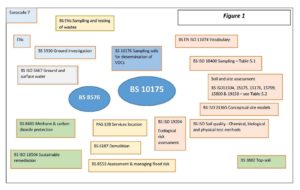Article provided by Mike Smith, Vice-Chair, BSI committee EH4-Soil quality
This new AGS guidance document provides key information required for a proper understanding and use Standard Guidance documents and Standard Specifications such as conventions in the use of language and the need for consistent use of terminology. It also provides information about in which Standards guidance on various topics such as investigation, reporting and remediation can be found.
BS 10175:2011 + A2:2017 Investigation of potentially contaminated sites -Code of practice is the key British Standard relating to the investigation and development of potentially, and proven, contaminated land. However, its proper application depends on following the recommendations or requirements of a constellation of other standards documents (Guidance and Specifications) many of which are European and/or International Standards- see Figure 1. Of particular importance are BS 8576: 2013 Guidance on investigations for ground gas – Permanent gases and Volatile Organic Compounds, BS 10176:2020 Taking soil samples for determination of volatile organic compounds (VOCs) – Specification and the BS ISO 18400 Soil quality – Sampling series of standards. BS 5930:2015 + A1:2020 Code of practice for ground investigations is important not only in respect of geotechnical investigations but also for the guidance it provides on combined geotechnical and geoenvironmental investigations.
Over two hundred guidance documents and Specifications have been produced by the ISO and CEN Technical Committees responsible for soil quality (ISO TC190 Soil quality and CEN TC444 Environmental characterization of solid matrices) including chemical analytical methods, physical test methods, biological test methods and guidance on what to look for when investigations are required for particular purposes. In line with the scopes of BS EH4 Soil quality (the relevant BSI committee), CEN TC 444 and ISO TC190, these various documents cover not only potentially contaminated sites, but natural and near-natural (e.g. farmed) soils, and contribute to understanding interactions between soil and global warming; concepts such as the health of the soil, sustainable use of soil and ecosystem services; and the actual and potential environmental impacts of existing and new chemicals
It is important to recognise that Standards are consensus documents prepared by technical experts and are subject to public consultation – any member of the public is entitled to see and comment on them, but the continuing difficulty that BSI EH4 has in meeting its obligations in this respect is how to let potentially interested parties know that draft documents exist. The formal position is that the representatives of organisations such as AGS are expected to inform and communicate with those they represent (so if you think you are missing out on information about draft standards the first route for complaint should be to AGS or other organisations to which you belong).
EH4 actively seeks to broaden its membership. The wider the membership of EH4, the greater the confidence that the standards produced are technically sound and known about by potential users from a wide variety of backgrounds. It also increases the pool of people from which it might be possible to draw on from time to time to represent the UK in ISO and CEN Working Groups.
Most of the members of EH4 represent a nominating body but membership is also open to individuals with particular expertise. BSI provides guidance on its web site on how to get involved with standards (How to get involved with standards). All enquiries will be sent to the relevant committee manager. Alternatively, contact the Committee Manager Jessy Matthew (Jessy.Mathew@bsigroup.com ).
Standards Relating to Investigation, Assessment, Remediation and Development of Potentially Contaminated and Contaminated Sites can be downloaded here.
